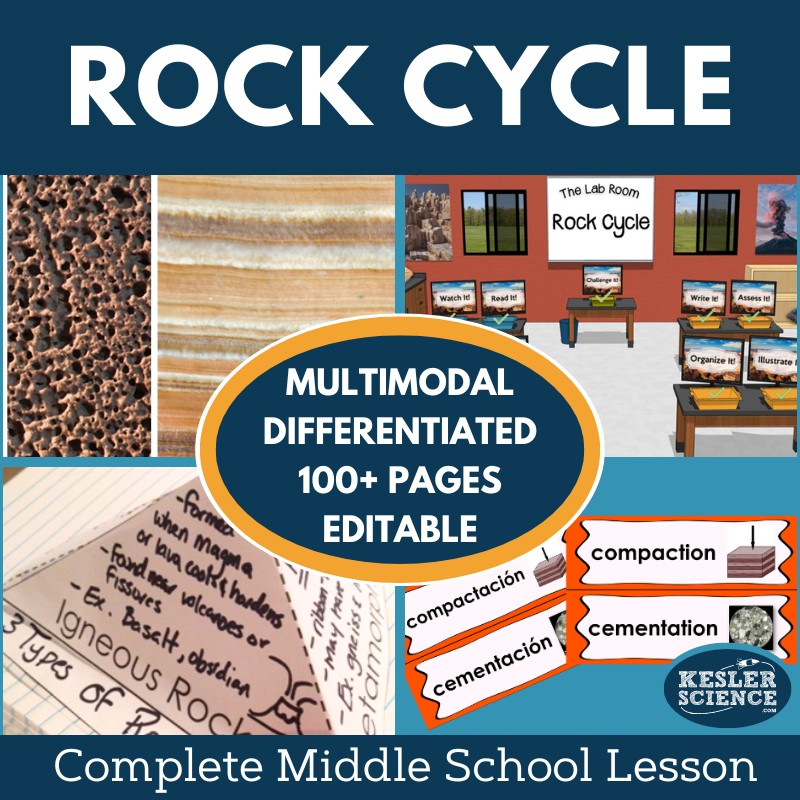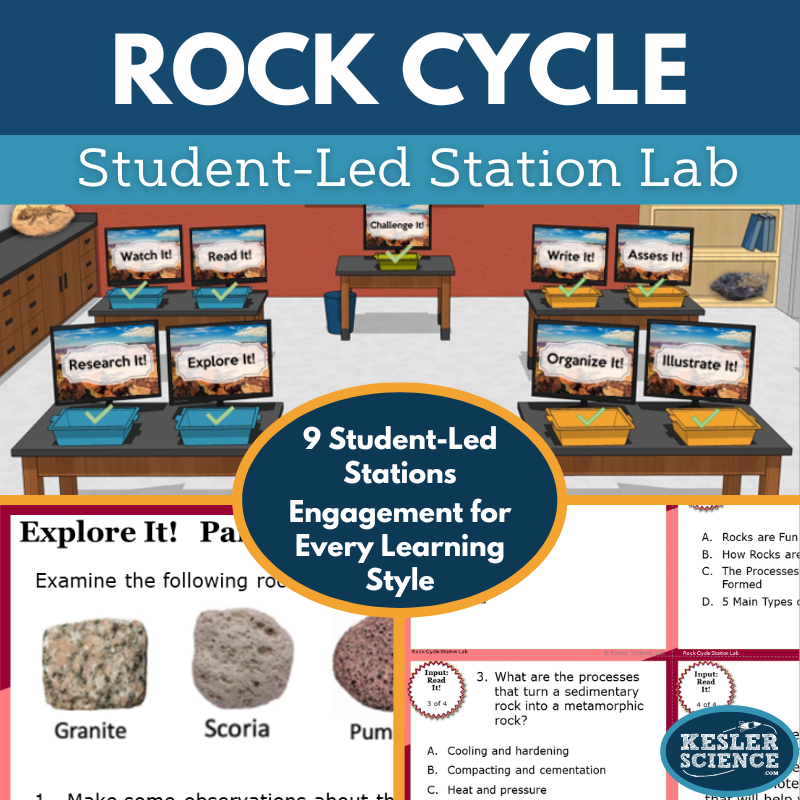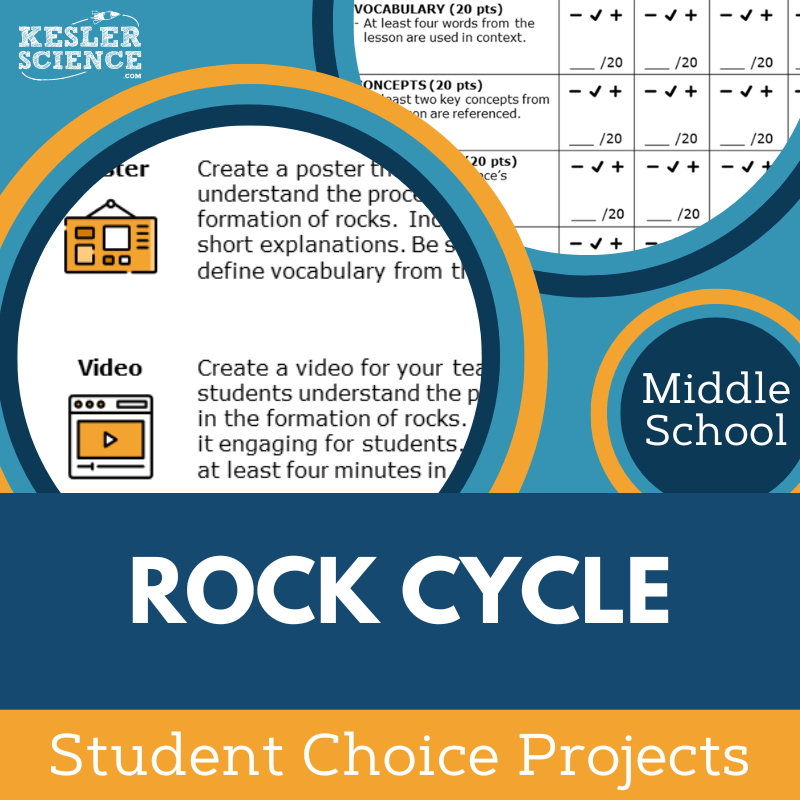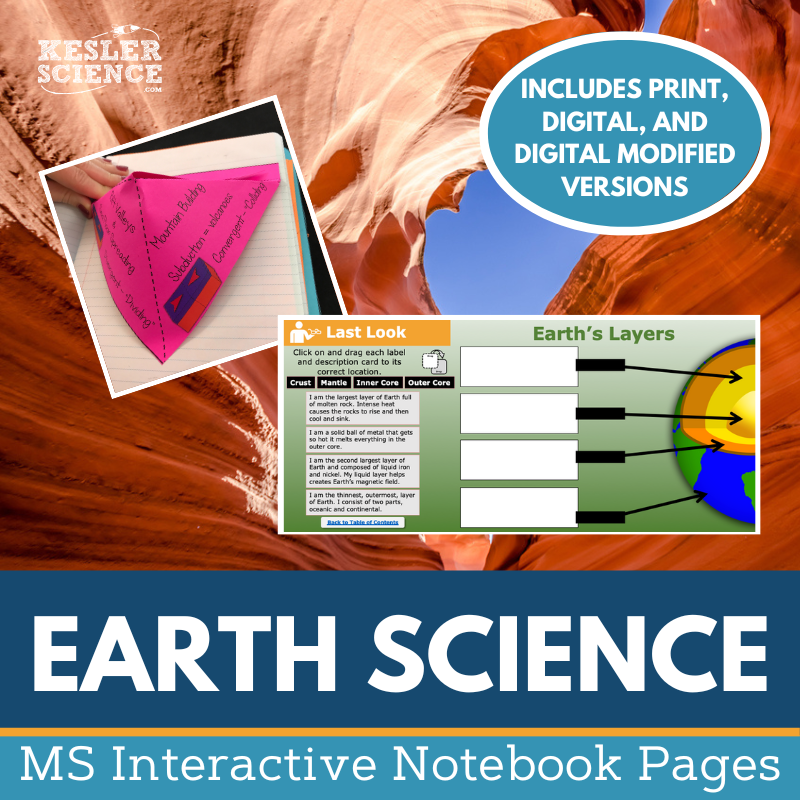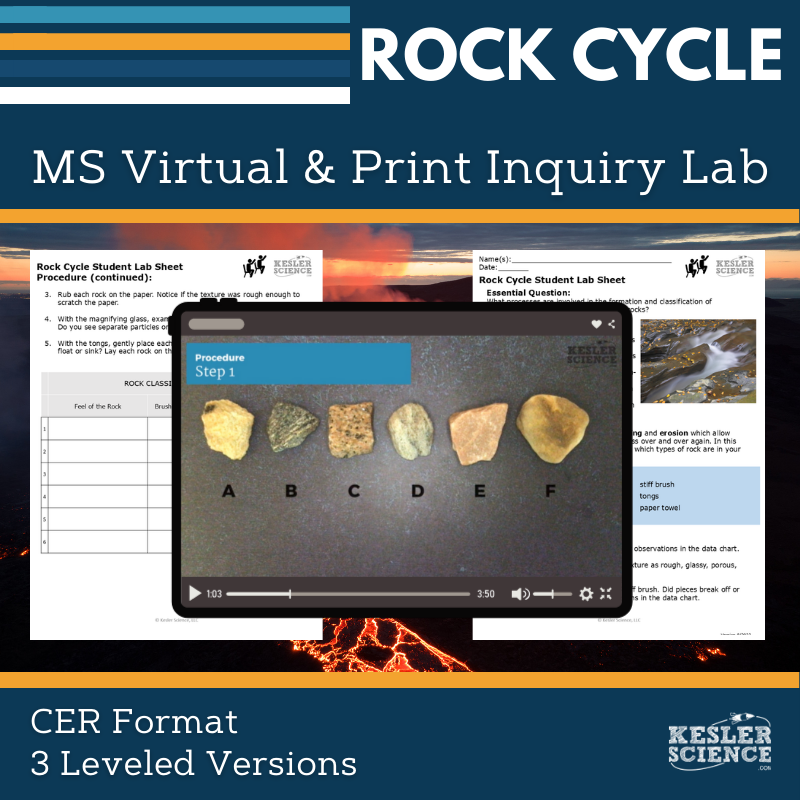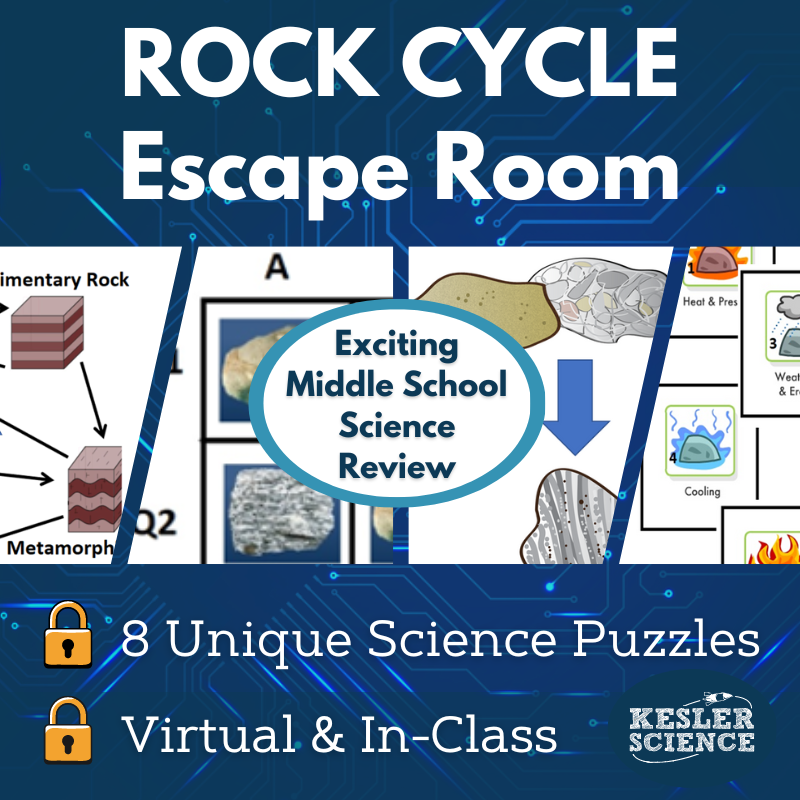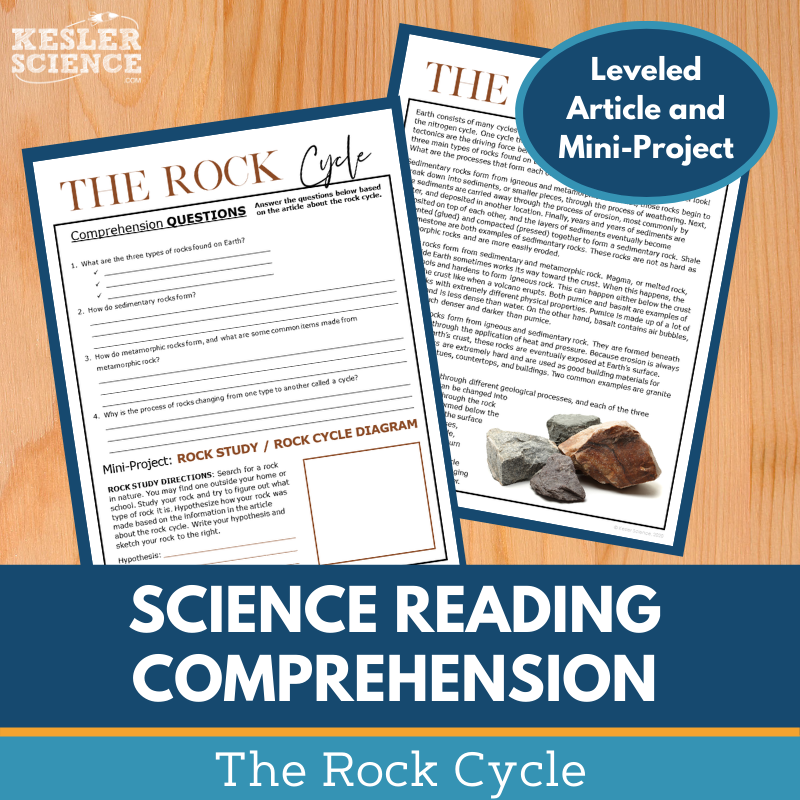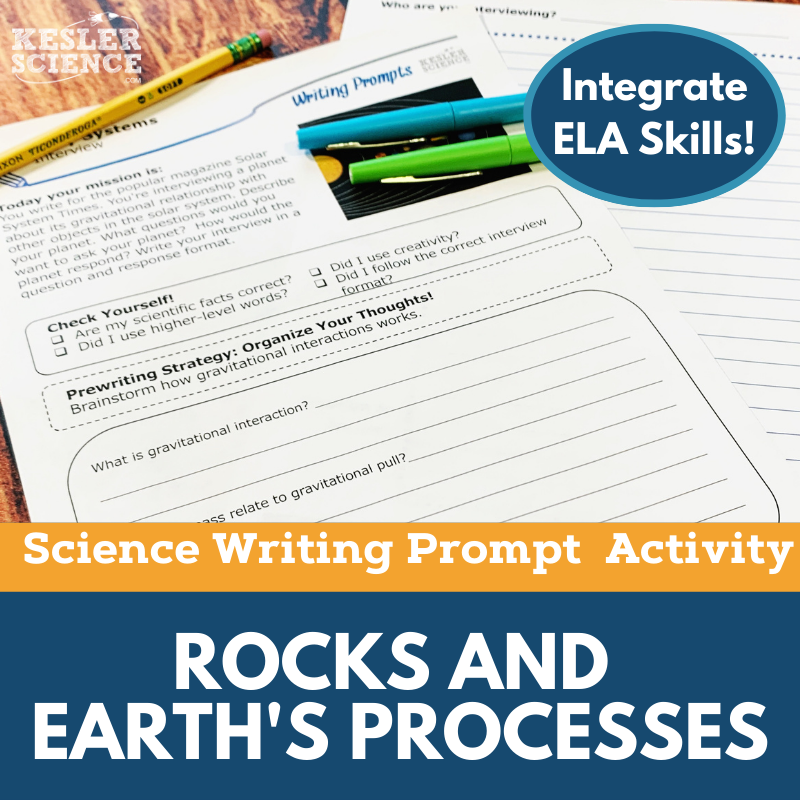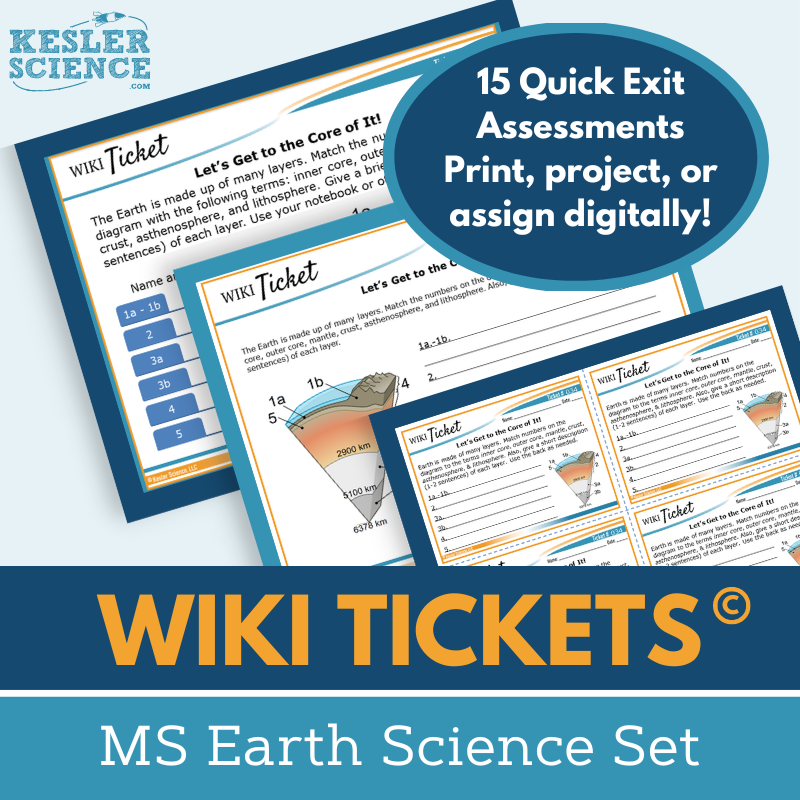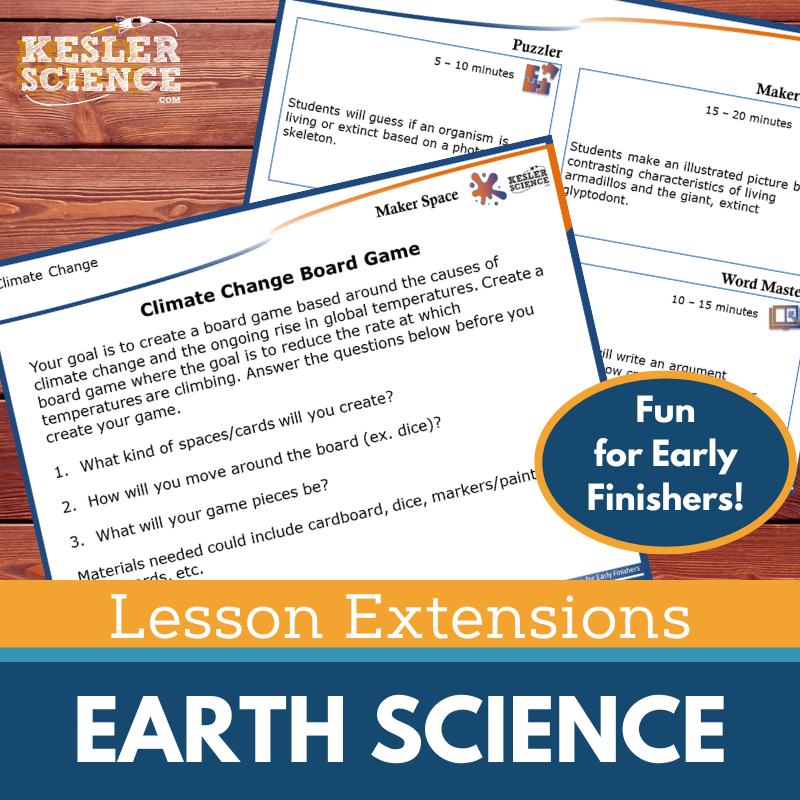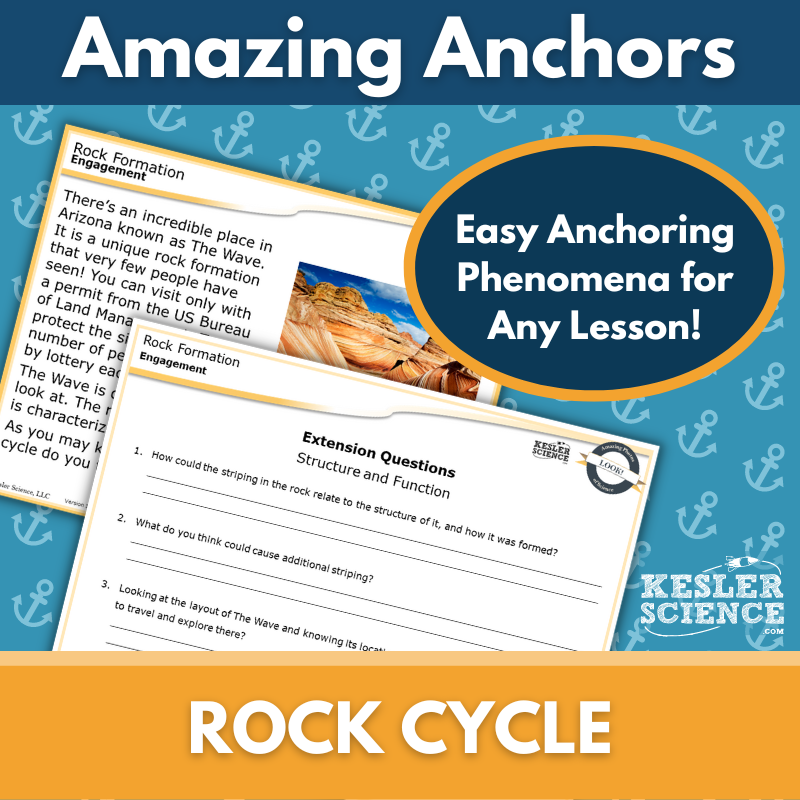Rock Cycle Activities for Middle School Science
The Kesler Science Rock Cycle resources provide middle school students with engaging, hands-on learning experiences to explore the processes involved in the formation and classification of igneous, sedimentary, and metamorphic rocks. The resources below will give students a comprehensive understanding of the rock cycle. All of the following materials are also included in the Kesler Science Membership.
This comprehensive middle school rock cycle unit follows the 5E Instructional Model and provides everything needed for a low-prep, engaging learning experience. Aligned with the 2017 TEKS, the lesson focuses on helping students explore the processes involved in the formation and classification of igneous, sedimentary, and metamorphic rocks. It includes editable presentations, differentiated worksheets, interactive notebook pages, student-choice projects, and assessments in both English and Spanish, supporting diverse learning styles and classroom settings.
During the Exploration phase, students rotate through nine differentiated, student-led stations. Input stations include hands-on experiments, readings, videos, and digital research, while output stations allow students to demonstrate their understanding through writing, card sorts, sketches, and assessments. A challenge station provides enrichment for early finishers. The Explanation phase features editable PowerPoints and note-taking templates, and the Elaboration phase offers creative projects that deepen understanding of the rock cycle.
Assessment materials in the Evaluation phase are aligned to STAAR 2.0 and include both standard and modified versions, along with review worksheets and discussion prompts. With full support for virtual and in-person instruction, this unit empowers teachers to implement an engaging, multimodal approach to teaching the rock cycle.
This comprehensive middle school rock cycle unit follows the 5E Instructional Model and provides everything needed for a low-prep, engaging learning experience. Aligned with the 2017 TEKS, the lesson focuses on helping students explore the processes involved in the formation and classification of igneous, sedimentary, and metamorphic rocks. It includes editable presentations, differentiated worksheets, interactive notebook pages, student-choice projects, and assessments in both English and Spanish, supporting diverse learning styles and classroom settings.
During the Exploration phase, students rotate through nine differentiated, student-led stations. Input stations include hands-on experiments, readings, videos, and digital research, while output stations allow students to demonstrate their understanding through writing, card sorts, sketches, and assessments. A challenge station provides enrichment for early finishers. The Explanation phase features editable PowerPoints and note-taking templates, and the Elaboration phase offers creative projects that deepen understanding of the rock cycle.
Assessment materials in the Evaluation phase are aligned to STAAR 2.0 and include both standard and modified versions, along with review worksheets and discussion prompts. With full support for virtual and in-person instruction, this unit empowers teachers to implement an engaging, multimodal approach to teaching the rock cycle.
Engage your students with this modular, student-led station lab focused on the rock cycle. Designed for both in-class and virtual environments, this activity allows middle school students to classify rocks by the processes that form them through nine differentiated stations. The lab is low-prep and high-impact, supporting a variety of learning styles while empowering students to guide their own learning journey.
The station lab includes eight core activities plus a bonus challenge station for early finishers. Input stations introduce new concepts through hands-on demonstrations, short reading passages in English and Spanish, online research, and engaging videos. Output stations give students opportunities to organize information with manipulatives, illustrate models, write responses, and complete assessments using task cards and vocabulary exercises.
Every station is fully resourced with signage, task cards, and student materials, compatible with PowerPoint and Google Slides for easy use. Whether students are drawing, writing, or experimenting, this differentiated experience reinforces understanding of the rock cycle while giving teachers the flexibility to facilitate rather than lead.
Engage your students with this modular, student-led station lab focused on the rock cycle. Designed for both in-class and virtual environments, this activity allows middle school students to classify rocks by the processes that form them through nine differentiated stations. The lab is low-prep and high-impact, supporting a variety of learning styles while empowering students to guide their own learning journey.
The station lab includes eight core activities plus a bonus challenge station for early finishers. Input stations introduce new concepts through hands-on demonstrations, short reading passages in English and Spanish, online research, and engaging videos. Output stations give students opportunities to organize information with manipulatives, illustrate models, write responses, and complete assessments using task cards and vocabulary exercises.
Every station is fully resourced with signage, task cards, and student materials, compatible with PowerPoint and Google Slides for easy use. Whether students are drawing, writing, or experimenting, this differentiated experience reinforces understanding of the rock cycle while giving teachers the flexibility to facilitate rather than lead.
The Kesler Science Rock Cycle Student Choice Projects offer middle school students a range of project options to match their individual learning styles. With six student-led project choices and a "design your own" option, students have the freedom to create projects that showcase their understanding of the rock cycle. A customizable grading rubric allows assessments by teachers, peers, or students themselves.
These flexible, dynamic projects are differentiated to accommodate a variety of student needs. Teachers can modify the rubric for specific requirements and assign combinations of projects to challenge advanced students. The lesson provides multimodal, creative opportunities for students to demonstrate their knowledge.
The resource includes nine project options, editable rubric pages, and teacher directions for support. Most projects require basic classroom supplies like paper and markers, and many can be completed digitally. Some projects may involve crafting supplies for hands-on activities.
The Kesler Science Rock Cycle Student Choice Projects offer middle school students a range of project options to match their individual learning styles. With six student-led project choices and a "design your own" option, students have the freedom to create projects that showcase their understanding of the rock cycle. A customizable grading rubric allows assessments by teachers, peers, or students themselves.
These flexible, dynamic projects are differentiated to accommodate a variety of student needs. Teachers can modify the rubric for specific requirements and assign combinations of projects to challenge advanced students. The lesson provides multimodal, creative opportunities for students to demonstrate their knowledge.
The resource includes nine project options, editable rubric pages, and teacher directions for support. Most projects require basic classroom supplies like paper and markers, and many can be completed digitally. Some projects may involve crafting supplies for hands-on activities.
The Kesler Science Earth Science Interactive Notebook Bundle is a must-have for teachers who want to provide an interactive learning experience in earth science. It includes both print and digital versions, making it a versatile resource for traditional classrooms, 1:1 environments, and distance learning.
The bundle covers a wide range of earth science topics, including Continental Drift Theory, plate boundaries, rocks and minerals, the rock cycle, Earth’s layers, volcanoes, earthquakes, and more. It also features activities like Venn diagrams, topographic maps, and reflection pages to help students demonstrate understanding and make connections between concepts.
The digital version includes a unique interactive notebook PowerPoint, which can be uploaded to Google Slides or learning management systems like MS Teams and Canvas. The paper version provides blank and pre-filled templates, along with color photos to guide students in completing each activity. Both versions come with a teacher answer key and a modified version for students with accommodations.
The Kesler Science Earth Science Interactive Notebook Bundle is a must-have for teachers who want to provide an interactive learning experience in earth science. It includes both print and digital versions, making it a versatile resource for traditional classrooms, 1:1 environments, and distance learning.
The bundle covers a wide range of earth science topics, including Continental Drift Theory, plate boundaries, rocks and minerals, the rock cycle, Earth’s layers, volcanoes, earthquakes, and more. It also features activities like Venn diagrams, topographic maps, and reflection pages to help students demonstrate understanding and make connections between concepts.
The digital version includes a unique interactive notebook PowerPoint, which can be uploaded to Google Slides or learning management systems like MS Teams and Canvas. The paper version provides blank and pre-filled templates, along with color photos to guide students in completing each activity. Both versions come with a teacher answer key and a modified version for students with accommodations.
The Rock Cycle Inquiry Lab aligns with NGSS by helping students investigate and classify sedimentary, igneous, and metamorphic rocks based on their physical characteristics and formation processes. Students test various rock samples, reflect on why each sample fits a specific category, and explore the geologic processes that create these rock types.
This lab is offered in both digital and print formats, with built-in differentiation through three levels: dependent (guided), modified (most structured), and independent (student-led). Each version includes comprehension questions, Claim-Evidence-Reasoning prompts, and reflection sections. The digital format requires no materials and features fully interactive elements, making it a great option for absent students or virtual classrooms.
Hands-on activities use standard classroom materials such as rock samples, brushes, tongs, and magnifying glasses. Editable pages, teacher guides, and answer keys make the lab easy to adapt and implement, while supporting student engagement through multimodal learning and inquiry-based science practices.
The Rock Cycle Inquiry Lab aligns with NGSS by helping students investigate and classify sedimentary, igneous, and metamorphic rocks based on their physical characteristics and formation processes. Students test various rock samples, reflect on why each sample fits a specific category, and explore the geologic processes that create these rock types.
This lab is offered in both digital and print formats, with built-in differentiation through three levels: dependent (guided), modified (most structured), and independent (student-led). Each version includes comprehension questions, Claim-Evidence-Reasoning prompts, and reflection sections. The digital format requires no materials and features fully interactive elements, making it a great option for absent students or virtual classrooms.
Hands-on activities use standard classroom materials such as rock samples, brushes, tongs, and magnifying glasses. Editable pages, teacher guides, and answer keys make the lab easy to adapt and implement, while supporting student engagement through multimodal learning and inquiry-based science practices.
The Rock Cycle Escape Room is an interactive, student-centered activity that helps students demonstrate their understanding of the rock cycle, including igneous, sedimentary, and metamorphic rocks, as well as processes like weathering, erosion, compaction, cementation, heat and pressure, and cooling. Designed to align with middle school science content, this immersive experience engages students in applying their knowledge through eight independent puzzles, which teachers can use in any order to fit their class time and objectives.
This escape room can be set up in multiple ways to fit your classroom needs. A simple and cost-effective option uses manila envelopes to organize the puzzles, while a more elaborate version includes a lockout hasp, locks, and a storage box for a more authentic feel. Printable materials and all necessary directions are included. For online learning, students can access a Single Student Digital Version via PowerPoint or Google Slides, or use the print-at-home PDF version, making it adaptable for both in-person and remote instruction.
The resource includes everything needed for implementation: teacher directions, detailed answer keys, editable digital files, a digital answer sheet via Google Forms, and a video challenge to kick off the activity. Also included are printable props for all puzzles, over 50 prize ideas, reward templates, and fun signs for student photos at the end. With its flexible format and engaging content, this escape room provides an exciting and educational way to explore the rock cycle.
The Rock Cycle Escape Room is an interactive, student-centered activity that helps students demonstrate their understanding of the rock cycle, including igneous, sedimentary, and metamorphic rocks, as well as processes like weathering, erosion, compaction, cementation, heat and pressure, and cooling. Designed to align with middle school science content, this immersive experience engages students in applying their knowledge through eight independent puzzles, which teachers can use in any order to fit their class time and objectives.
This escape room can be set up in multiple ways to fit your classroom needs. A simple and cost-effective option uses manila envelopes to organize the puzzles, while a more elaborate version includes a lockout hasp, locks, and a storage box for a more authentic feel. Printable materials and all necessary directions are included. For online learning, students can access a Single Student Digital Version via PowerPoint or Google Slides, or use the print-at-home PDF version, making it adaptable for both in-person and remote instruction.
The resource includes everything needed for implementation: teacher directions, detailed answer keys, editable digital files, a digital answer sheet via Google Forms, and a video challenge to kick off the activity. Also included are printable props for all puzzles, over 50 prize ideas, reward templates, and fun signs for student photos at the end. With its flexible format and engaging content, this escape room provides an exciting and educational way to explore the rock cycle.
In the Kesler Science Rock Cycle comprehension reading, students explore the rock cycle by reading a nonfiction article about how each type of rock forms. Afterward, they complete comprehension questions and create a rock cycle diagram, along with a story for a rock they find. This hands-on mini-project reinforces key concepts and enhances students' science literacy.
The leveled science reading passages, appropriate for grades 6-8 (or advanced 5th graders), feature Lexile levels ranging from 1100-1300. Each passage is paired with 5-7 comprehension questions and a mini-project. Cornell notes templates are also provided to support students in organizing their thoughts.
This resource is versatile for both in-person and virtual learning. It includes digital files that can be used with platforms like Google Classroom, MS Teams, and Canvas, allowing students to respond directly in the document. The lesson is ideal for a range of instructional purposes, including extra credit, make-up work, or building science literacy.
In the Kesler Science Rock Cycle comprehension reading, students explore the rock cycle by reading a nonfiction article about how each type of rock forms. Afterward, they complete comprehension questions and create a rock cycle diagram, along with a story for a rock they find. This hands-on mini-project reinforces key concepts and enhances students' science literacy.
The leveled science reading passages, appropriate for grades 6-8 (or advanced 5th graders), feature Lexile levels ranging from 1100-1300. Each passage is paired with 5-7 comprehension questions and a mini-project. Cornell notes templates are also provided to support students in organizing their thoughts.
This resource is versatile for both in-person and virtual learning. It includes digital files that can be used with platforms like Google Classroom, MS Teams, and Canvas, allowing students to respond directly in the document. The lesson is ideal for a range of instructional purposes, including extra credit, make-up work, or building science literacy.
The Kesler Science Rocks and Earth Processes Science Writing Prompt engages middle school students by having them creatively test their knowledge through skits and drama. These activities extend students' science reasoning and exploration, allowing them to enrich their writing skills in a fun and interactive way. Designed for virtual learning, students can stay engaged both in and outside the classroom.
Aligned with TEKS or NGSS standards, these low-prep, student-centered activities serve as excellent elaboration or review tools when combined with other Kesler products. The writing prompts are flexible and can be used for a variety of purposes, such as cross-curricular activities, pre-assessments, or extra credit.
Included with the purchase are teacher directions, rubrics, and digital versions that can be shared or projected in the classroom. The resources come in full-sized and half-sheet handouts, along with a PowerPoint version for digital use, making it easy to adapt the activity to different learning environments.
The Kesler Science Rocks and Earth Processes Science Writing Prompt engages middle school students by having them creatively test their knowledge through skits and drama. These activities extend students' science reasoning and exploration, allowing them to enrich their writing skills in a fun and interactive way. Designed for virtual learning, students can stay engaged both in and outside the classroom.
Aligned with TEKS or NGSS standards, these low-prep, student-centered activities serve as excellent elaboration or review tools when combined with other Kesler products. The writing prompts are flexible and can be used for a variety of purposes, such as cross-curricular activities, pre-assessments, or extra credit.
Included with the purchase are teacher directions, rubrics, and digital versions that can be shared or projected in the classroom. The resources come in full-sized and half-sheet handouts, along with a PowerPoint version for digital use, making it easy to adapt the activity to different learning environments.
The Kesler Science Earth Science WIKI Tickets provide formative assessments for 6th-8th grade science topics, offering flexible options to check students' understanding in an engaging format. Each topic includes five versions: a full-screen projection version, three handout sizes (full, split, and quarter-page), and an interactive digital version for Google Slides or PowerPoint.
The Earth Science WIKI Tickets cover a wide range of earth science topics, including minerals, plate tectonics, the rock cycle, and human impact on the environment. Some topics have more than one ticket, but every topic is covered by at least one.
The WIKI Tickets can be used in both in-person and virtual learning environments. They work great as exit tickets, bellringers, or informal assessments during lessons. Teachers can project them, use printable handouts, or assign them digitally for remote students, making them adaptable for any teaching situation.
The Kesler Science Earth Science WIKI Tickets provide formative assessments for 6th-8th grade science topics, offering flexible options to check students' understanding in an engaging format. Each topic includes five versions: a full-screen projection version, three handout sizes (full, split, and quarter-page), and an interactive digital version for Google Slides or PowerPoint.
The Earth Science WIKI Tickets cover a wide range of earth science topics, including minerals, plate tectonics, the rock cycle, and human impact on the environment. Some topics have more than one ticket, but every topic is covered by at least one.
The WIKI Tickets can be used in both in-person and virtual learning environments. They work great as exit tickets, bellringers, or informal assessments during lessons. Teachers can project them, use printable handouts, or assign them digitally for remote students, making them adaptable for any teaching situation.
The Kesler Science Earth Science Lesson Extensions offer engaging activities for fast finishers, fostering critical thinking and creativity. These extensions are designed to scaffold learning for students ready to dive deeper into earth science topics while aligning with NGSS and TEKS standards. They provide a fun yet rigorous way to enhance lessons and keep students focused during independent work or testing.
Each Lesson Extension includes four core activities: a Puzzler to improve problem-solving, a Maker Space to promote STEAM connections, a Tech Connection to demonstrate learning through digital media, and a Word Master activity to integrate creative writing. These activities ensure students engage with the content in a variety of ways, helping reinforce their understanding.
The Lesson Extensions come with teacher directions, answer keys, and both paper and digital versions for flexibility. Perfect for wrapping up lessons or providing enrichment, these extensions cover a wide range of earth science topics like climate change, fossil fuels, and plate tectonics, all while meeting high-level science standards.
The Kesler Science Earth Science Lesson Extensions offer engaging activities for fast finishers, fostering critical thinking and creativity. These extensions are designed to scaffold learning for students ready to dive deeper into earth science topics while aligning with NGSS and TEKS standards. They provide a fun yet rigorous way to enhance lessons and keep students focused during independent work or testing.
Each Lesson Extension includes four core activities: a Puzzler to improve problem-solving, a Maker Space to promote STEAM connections, a Tech Connection to demonstrate learning through digital media, and a Word Master activity to integrate creative writing. These activities ensure students engage with the content in a variety of ways, helping reinforce their understanding.
The Lesson Extensions come with teacher directions, answer keys, and both paper and digital versions for flexibility. Perfect for wrapping up lessons or providing enrichment, these extensions cover a wide range of earth science topics like climate change, fossil fuels, and plate tectonics, all while meeting high-level science standards.
This Amazing Anchors Phenomenon Lesson introduces and reinforces the rock cycle through a real-world connection to the Wave, a striking rock formation in Arizona. Students begin with an introductory reading that includes comprehension and extension questions to build background knowledge and engagement. A second reading breaks down the science behind the rock cycle in student-friendly language, followed by questions that deepen understanding.
This TEKS-aligned resource is designed to supplement your main lesson, fitting perfectly into the Engagement and Elaborate phases of the 5E model. It includes teacher directions with answer keys, editable slides for digital sharing, and print options in both full- and half-sheet formats for interactive notebooks. Materials are ready for both classroom and virtual instruction.
The lesson includes a differentiated version to support students who benefit from modified language and sentence starters. With both paper and digital formats, this no-prep activity allows students to explore the rock cycle through the lens of a compelling geologic phenomenon.
This Amazing Anchors Phenomenon Lesson introduces and reinforces the rock cycle through a real-world connection to the Wave, a striking rock formation in Arizona. Students begin with an introductory reading that includes comprehension and extension questions to build background knowledge and engagement. A second reading breaks down the science behind the rock cycle in student-friendly language, followed by questions that deepen understanding.
This TEKS-aligned resource is designed to supplement your main lesson, fitting perfectly into the Engagement and Elaborate phases of the 5E model. It includes teacher directions with answer keys, editable slides for digital sharing, and print options in both full- and half-sheet formats for interactive notebooks. Materials are ready for both classroom and virtual instruction.
The lesson includes a differentiated version to support students who benefit from modified language and sentence starters. With both paper and digital formats, this no-prep activity allows students to explore the rock cycle through the lens of a compelling geologic phenomenon.
Year-Round Resources
These year-round activities will increase your students' understanding of many middle school science topics. All of these activities are also included in the Kesler Science Membership.
Visual Data & Graphing
You're not alone if your students struggle with understanding graphs, charts, and tables. It's a skill that takes an enormous amount of practice. This resource will help students build a strong foundation in analyzing data and creating their own data visualizations.
Bell Ringers and Warm-Ups
These middle school science bell ringers are an excellent way to engage your students as soon as they walk into your classroom. This comprehensive FULL YEAR resource includes everything you need to start off each science class with an interesting warm-up activity.
Review Board Games
Each game board has been carefully designed to keep students engaged. There are 10 different action spaces on each board and dozens of question cards. All of the actions are related to science concepts and keep the students motivated throughout the game.
Each game is ready to play. Simply print out the board and the cards and let the students enjoy reviewing nine different units.
Essential Questions
Below are the essential questions associated with the lessons and activities included in this unit. This topic is only one of more than 100 middle school science topics included in the Kesler Science Membership.
-
What processes are involved in the formation and classification of metamorphic, sedimentary, and igneous rocks?
Kesler Science Membership
Imagine never having to search for another middle school science lesson again. The membership gives you access to ALL of the Kesler Science products in one place (Yes, including everything above).
Say goodbye to long hours of lesson prep.

